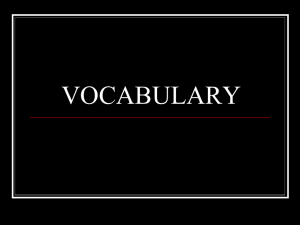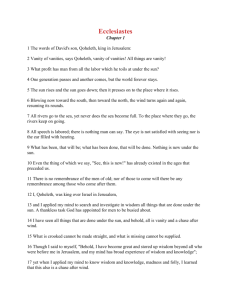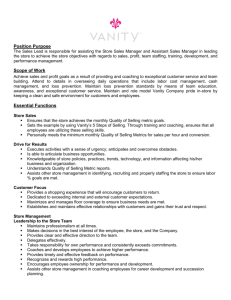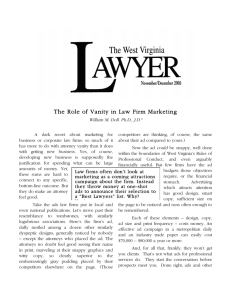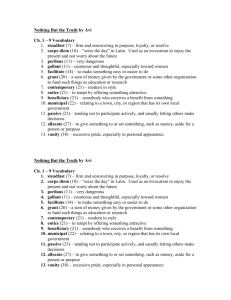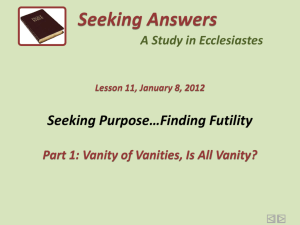Document 10465671
advertisement
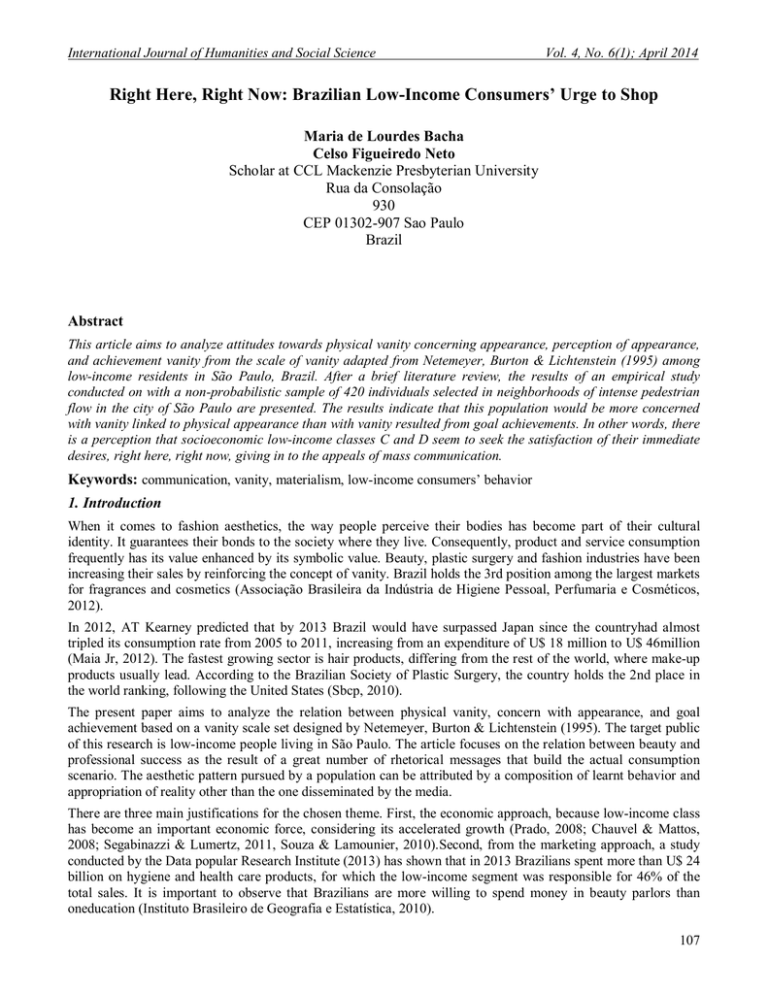
International Journal of Humanities and Social Science Vol. 4, No. 6(1); April 2014 Right Here, Right Now: Brazilian Low-Income Consumers’ Urge to Shop Maria de Lourdes Bacha Celso Figueiredo Neto Scholar at CCL Mackenzie Presbyterian University Rua da Consolação 930 CEP 01302-907 Sao Paulo Brazil Abstract This article aims to analyze attitudes towards physical vanity concerning appearance, perception of appearance, and achievement vanity from the scale of vanity adapted from Netemeyer, Burton & Lichtenstein (1995) among low-income residents in São Paulo, Brazil. After a brief literature review, the results of an empirical study conducted on with a non-probabilistic sample of 420 individuals selected in neighborhoods of intense pedestrian flow in the city of São Paulo are presented. The results indicate that this population would be more concerned with vanity linked to physical appearance than with vanity resulted from goal achievements. In other words, there is a perception that socioeconomic low-income classes C and D seem to seek the satisfaction of their immediate desires, right here, right now, giving in to the appeals of mass communication. Keywords: communication, vanity, materialism, low-income consumers’ behavior 1. Introduction When it comes to fashion aesthetics, the way people perceive their bodies has become part of their cultural identity. It guarantees their bonds to the society where they live. Consequently, product and service consumption frequently has its value enhanced by its symbolic value. Beauty, plastic surgery and fashion industries have been increasing their sales by reinforcing the concept of vanity. Brazil holds the 3rd position among the largest markets for fragrances and cosmetics (Associação Brasileira da Indústria de Higiene Pessoal, Perfumaria e Cosméticos, 2012). In 2012, AT Kearney predicted that by 2013 Brazil would have surpassed Japan since the countryhad almost tripled its consumption rate from 2005 to 2011, increasing from an expenditure of U$ 18 million to U$ 46million (Maia Jr, 2012). The fastest growing sector is hair products, differing from the rest of the world, where make-up products usually lead. According to the Brazilian Society of Plastic Surgery, the country holds the 2nd place in the world ranking, following the United States (Sbcp, 2010). The present paper aims to analyze the relation between physical vanity, concern with appearance, and goal achievement based on a vanity scale set designed by Netemeyer, Burton & Lichtenstein (1995). The target public of this research is low-income people living in São Paulo. The article focuses on the relation between beauty and professional success as the result of a great number of rhetorical messages that build the actual consumption scenario. The aesthetic pattern pursued by a population can be attributed by a composition of learnt behavior and appropriation of reality other than the one disseminated by the media. There are three main justifications for the chosen theme. First, the economic approach, because low-income class has become an important economic force, considering its accelerated growth (Prado, 2008; Chauvel & Mattos, 2008; Segabinazzi & Lumertz, 2011, Souza & Lamounier, 2010).Second, from the marketing approach, a study conducted by the Data popular Research Institute (2013) has shown that in 2013 Brazilians spent more than U$ 24 billion on hygiene and health care products, for which the low-income segment was responsible for 46% of the total sales. It is important to observe that Brazilians are more willing to spend money in beauty parlors than oneducation (Instituto Brasileiro de Geografia e Estatística, 2010). 107 © Center for Promoting Ideas, USA www.ijhssnet.com Last but not least, academically, literature review reveals that over the last few years, the topic of the low-income class has been broadly approached by scholars. Nevertheless, studies on vanity and materialism are rare, showing there is a field to be explored in order to fulfill society´s need for information on this topic. 2. Theoretical Background The first marketing researchers on vanity were Netemeyer, Burton, Lichtenstein (1995). According to these authors, vanity is a construct that describes the concern one has with his or her appearance (plastic surgery, tattoos, jewelry, make-up, fashion, food, and shape) and achievements (consumption and ostentation, symbolic and conspicuous consumption, self-extended and materialism). The most important themes related to vanity in Brazilian literature as well as abroad are: body and aesthetic (Greine & Katz, 2001; Lucas; Hoff, 2006; Rhode, 2009); vanity and achievements (Zhou & Belk, 2004; Stanat, 2005); materialism (Belk, 1985; Tang et al., 2000; Durvasula & Lysonski, 2010); narcissism (Galvin, Waldman & Balthazard, 2010); consumption (Abdala, 2008; Braga, Molina & Cade, 2007); cultural impact (Greine & Katz, 2001; Teimourpour, 2011), and; vanity scale validation (Greine & Katz, 2001; Teimourpour, 2011). When consumers identify themselves with society, their vanity level tends to change (Durvasula etal, 2001) and attractive people tend to be seen as vain (Abdala, 2008). Barki (2005) has shown that each social class has different shopping habits, which are determined by values, beliefs and social position; a different perception of value is determined not only by lower prices, but also a stronger need to compensate for dignity deficit and low self-esteem, a stronger preference for personal relationships, and high aspiration to feel socially included. Abdala (2008) considers that vanity is directly linked to beauty concern. The greater the concern, the greater the vanity. The more vain one is, the more money will be spent on products to increase one’s vanity. This way, there will be a vanity-consumption cycle. Vanity is no longer seen as a negative characteristic by many, especially in Brazil. Women tend to associate vanity with body care, separating vanity (positive) and futility (negative) (Edmonds, 2002). Bacha & Figueiredo (2012), on a study on low-income people in the city of São Paulo, have analyzed attitudes towards their bodies, physical activity, and vanity. Results show that people are aware of the benefits sports may bring and recognize the importance of weight loss to prevent health problems and increase general life quality. On the other hand, the study shows a difference between discourse and practice, that is, although respondents understand the importance of physical activities, many of them do not engage in these activities. The study reveals that low-income women in a constant struggle to look better do not seem to be concerned with their own weight. The authors concluded that there might be a different beauty concept among low-income people compared to other socioeconomic classes, and also compared to media messages regarding aesthetics. As for materialism, it can be defined as the "importance attached to the possession and acquisition of material goods in order to achieve life goals or desired states" (Richins & Dawson, 1992, p. 304; Belk, 1984, p. 291), as an individual´s interest in having and spending. Aristotle, in Book I of the Rhetoric, presents happiness as the highest good so an effort will be needed so you can reach it.“Assuming that happiness is success combined with virtue, or something provided with enough resources; or even a life filled with delight and security; or the abundance of goods and wealth with the ability to get and keep these advantages (…) From this definition of happiness it follows its main parts: good birth, great number of friends, the friendship of people with goodness in their hearts, wealth, healthy children, plenty of children, happy old age (…)” (Aristotle, 2002, p. 45). Burke (1969) comments on this passage, stating that it is mystical, “indeed, it is wholly realistic, involving the usual Aristotelian concern with the action when he refers human actions to seven causes (aitia): chance, nature, compulsion, habit, reason, anger and desire" (Burke 1969, p. 292).The materialistic attitude can be linked to the effort to acquire goods, which industries offer consumers, or the value that an individual's perspective on property represents, or the role that they play in real life. Studies show that regardless of socioeconomic level, consumers value the power of conquest and consider it an important tool that guides their actions, attitudes, judgments and comparisons between specific objects, as well as the judgment one makes about the meaning of possession. So, people who prioritize the acquisition of material goods can be named materialists, while individuals who do not feel the need to have and acquire more and more, are considered non-materialistic. 108 International Journal of Humanities and Social Science Vol. 4, No. 6(1); April 2014 Ponchio, Aranha & Todd (2006) studied the construct of materialism in the context of low-income consumers in Sao Paulo using the scales of Belk (1985) and Richins & Dawson (1992). The scale of Richins & Dawson (1992)was chosen to give support to this article and encompasses three dimensions: Centrality - a construct that indicates the role of possessions and acquisitions in people's lives (possessions and acquisitions would be central elements of materialistic life); Happiness - a construct that indicates an individual's level of hope considering the idea that possessions and acquisitions will bring happiness and well-being, and; Success - a construct that indicates one´s tendency to judge others and oneself on the quantity and quality of his or her possessions. Several authors analyzed the relationship between vanity and materialism, including Durvasula & Lysonski (2010), showing that attitudes towards money, materialism and vanity are affected by the power of prestige. The belief that money cannot only bring status and possessions, but also power and control over others, may contribute to the increased materialism and vanity among Chinese consumers. For marketers, the results indicate that products whose positioning is based on possession or use of money to indulge hedonism can be successful. However, some cases may worry ethicists because of the disorders associated with compulsive shopping and other problems found in consumerist societies. Accumulation, possession, and costs are central in societies adapted to the market culture. Money can allow extravagances and at the extreme, create new identities. Money can mean prestige. Indeed, money has more than just economic significance; it has a social significance that allows consumers to imitate each other in their choice and use of consumer goods. According to the authors, the literature review shows that money can represent a "profound ritual" that reflects the infinite facets of the culture in which it appears, and its tenure has a profound impact on consumers. There would be societies with a symbolic system that allows individuals to convert money into any "sacred symbol" they choose, so marketing can portray this symbolism of money and power as lifestyles and possessions. This representation can serve as a motivator for consumers to buy certain products as a way of identifying themselves. In another context, there are relevant studies on consumption and indebtedness, including Zerrenner (2007) and Lamounier & Souza (2010). In Brazil, there have been some changes between 2008 and2009: a reduction in income inequality and increased purchasing power of the low-income population; significant increase of employment and monthly income of the population, providing greater potential for a consumer society; low inflation and free credit financing agencies; stabilization of the national economy, since 1994, and; the minimum wage increased appropriately above inflation. Given the power of domestic consumption, individuals strengthen their materialistic desires of consumption, with the facilities provided by funding agencies that provide access to buying the goods and services that these people had never consumed before. According to Zerrenner (2007), positive attitudes to materialism and overconsumption may involve debt; individuals may find it difficult to repay their debts, and have low or no ability to manage their income, resulting in psychological problems. Despite the risks of excessive borrowing and its consequences, the new consumers are now faced with the opportunity to buy the things they were encouraged to by years of advertising discourse, which previously, due to their economic conditions, they could not. Now, the macro environmental conditions are favorable, which allow these people to finally fulfill their desires of consumption. 3. Methodological Procedures This work has an empirical and quantitative nature. A survey has been conducted with a non-probabilistic sample of 420 individuals selected in neighborhoods where pedestrian flow was intense in the city of São Paulo, such as Penha, Cangaíba, Arthur Alvin, Itaquera, Guaianazes, SãoMateus, Mooca, Ipiranga, Sacomã, Jabaquara and Vila Maria, because they are considered typical low-class neighborhoods (Malhotra, 2001; Hair et al, 2006). Respondents were grouped according to filters: living in the municipality of São Paulo and belonging to C and D socioeconomic classes (according to the Brazilian Economic Classification Scheme, 2010). Personal interviews were carried out using structured forms (questionnaires). The answers given to the questionnaires were typed into survey software SPSS. Fieldwork took place between April and June 2011. Although statistical considerations do not permit the development of inferences about the population from nonprobabilistic samples, we chose this type of sample in terms of cost and accessibility. 109 © Center for Promoting Ideas, USA www.ijhssnet.com 4. Empirical Research: Presentation and Discussion of the Main Results The sample is distributed as follows: gender (female - 57% - male -43%), socioeconomic class (C - 73%, D 27%), age (15 years old - 8%; 16-24 years old - 35%; 25-29 years old - 16%,30-39 years old - 22%, 40-49 years old - 12%, 50-60 years old - 8%; above 60 years old - 2%),education (up to elementary school - 30%; until elementary school - 21%; until incomplete high school - 20%; until incomplete higher education - 24%, graduate 5%), household income (up to 1minimum wage - 9%; between 2 and 5 minimum wages - 74%; between 6 and 10 minimum wages -13%; 11 or more minimum wages - 4%). 4.1 Assessing Vanity Scale For this study, it was chosen to adapt the scale of Netemeyer, Burton&, Lichtenstein (1995), which considers physical vanity and pride in goal achievements. When analyzing Table 1, it is observed that the highest percentages refer to physical vanity: “The way I present myself is extremely important to me” (75%); I am very concerned with my appearance (69%); I feel embarrassed if I do not look my best in public (62%); whereas percentages related to achievement are lower. 4.2 Debt, Savings The access to credit amenities and the uncontrolled consumption of the population currently result in high personal debts, because many individuals compromise a significant portion of their income to purchase goods and services. Considering the issue of debt, 29% of the sample has an installment loan booklet, 22% are overdue for payment, 31% have financing debt, 27% are due for payment or have financing debt, 40% have allowed another person to use their names for buying or financing something and 34% have used the name of another person to purchase or finance something. Moreover, if they were not making money for 3 months, 41% would certainly go into debt to paythe bills, 25%would probably go into debt to pay the bills and only 34% would not need aloan to pay the bills. According to Ponchio & Aranha (2007), economic situation is not the only factor leading to adverse borrowing for consumption: in some cases, the level of materialism cans virtually double the likelihood of getting an installment plan. Variables such as age, gender and income also substantively influence this probability. In Brazil, high interest rates and difficult credit approval are factors that used to restrict the consumption of the low-income population. While consumer credit has grown substantially in recent years, notably in terms of payroll loans, credit cards, debit cards and store cards, the rate of penetration of financial services in the world of low-income consumers still has great potential for growth. With regard to savings it was noted that more than a third of the sample (35%) do not usually save. Out of the 65% who do usually save, 67% do it to pay off debts, 62% usually save for times of need; 53% usually save to buy goods, 50% usually save for health expenses, and 37% usually save for leisure activities / tourism. According to Souza (2010), over-optimism may be the main cause of default on payments by the low-income class in the country, which includes individuals of class C, whose family income is between R$ 2,726.00 and R$ 5,450.00 monthly, and class D, between R$1,091.00 and R$ 2,725.00 monthly. Informal settlements and unstable family income streams are among other factors that determine indebtedness. Also according to Moura (2005), Neri (2008) and Lamounier & Souza (2010), the low-income segment has difficulty in managing their income because of overspending. The informal employment and income instability may represent a danger to this class, since lowincome individuals live in a vicious cycle of contracting new debts to pay off old ones. 4.3 Materialism The attitudes towards materialism were assessed according to five points of agreement, adapted from Ponchio & Todd (2006, 2007). Through factor analysis three components were found that explain 55% of the total variance and KMO = 0.802. The components are described in table 2.The component “centrality” is related to: “Spending a lot of money is among the most important things in life”, “I like to spend money on expensive things”, “I like to own things that impress people”, “I admire people who own homes, cars and expensive clothes”, “I like a lot of luxury in my life”, “One of the most important achievements in a person´s life includes the purchase of material goods” and “I try to keep my life as simple as possible”. The component “successan ” includes “I would be happier if I had more money to buy more stuff”, Buying thing gives me great pleasure”, 110 International Journal of Humanities and Social Science Vol. 4, No. 6(1); April 2014 “It bothers me when I cannot buy everything I want” and “My life would be better if I had not got things”. The component “happiness” refers to “I have everything I need to enjoy life”, “I love material goods less than other people I know”, “I would not be happier if I had better things”, “I usually buy only the things I need”. What is observed is a duality between the respondents. On one hand, the highest percentages were obtained from extremely consumerist attitudes: “Buying things gives me great pleasure” (74%), “It bothers me when I cannot buy everything I want” (58%) and “I like a lot of luxury in my life” (54%). On the other hand, there seems to be an uncomfortable feeling regarding the issue of consumerism: “I usually buy only the things I need” (72%), “I have everything I need to enjoy life” (62%), “I like material goods less than other people I know” (56%).Despite this, only 27% say “I try to keep my life as simple as possible”. This duality is very evident when one considers that 40% say “I’d be happier if I had more money to buy more stuff” and 37%say “My life would be better if I had not got things”; however, 52% think: “I would not be happier if I had better things”. 4.4 Results From the theoretical framework developed and tested, some factors influence low-income consumers’ attitudes regarding materialism and savings. Demographic variables such as gender and income were not significant, unlike age and education. The indicators which measured the dimensions of the attitude were significantly correlated to (P <or = 0, 01). The results are in accordance with literature review. The component "centrality" is influenced by vanity, considering perception of achievement, perception of appearance and concern with appearance. The component “success" is influenced by vanity considering perceived appearance and concern with appearance. The component "happiness" is influenced by vanity considering perceived appearance and perception of accomplishment. This component is directly linked to the satisfaction of consumers ‘desires. There was also a significant correlation among centrality, success and happiness, and propensity to save and say "usually save to pay debts" concerning the installment booklets or other financing plans. The results suggest that attitudinal changes are possible; attitudes can be strengthened over time, given the strong relationship between behavioral intention and behavior (Fishbein, Ajzen, 1975). 5. Conclusions Brazil has undergone a true metamorphosis, with decreasing income inequality and low-income consumers’ access to goods and services. In the midst of this transformation, low-income consumers have had contact with the market, and more than that, contact with their dreams, influenced by many years of advertising efforts engaged in the construction of desirable brands. Quick access to this "enchanted world" generated side effects, such as increased personal debt and reinforcement of a traditional feature already in the country: the lack of concern with the need to save for the future. Economic studies, published in various media, have shown that low ability to save has important consequences from both the perspective of individuals and the macroeconomic point of view, and it is one of the reasons for the lack of enough money to invest in infrastructure, telecommunications and education. Brazilians have had a significant increase in their income, but that increase in money has not been accompanied by increased educational and cultural investment. As a consequence, they find themselves seduced by innumerous fatuous desires for immediate pleasure, disconnected from further consideration of the need to buy such things or their own ability to pay the debts incurred. What we see, to monitor the movement of the market, is that the new consumers fulfill their dreams without thinking about the consequences. The need to show they are up to date may be a relevant manifestation of these consumers. They want that and they want it right here, right now. Their perception of beauty or success is also influenced by their way of being in the world, so that consumption reaffirms their new condition. Being beautiful and attractive, yet nutritionally poor, seems to be the desire of these new consumers, so it is understandable that these consumers may be happy to present themselves to society as a Big Mac. The future will show the consequences of this careless consumption, and interest rates for debt financing may rise along with the cholesterol levels of those compulsive consumers. The authors hope that this study provides some interesting insights into the interaction of the data described and consumers’ attitudes towards vanity, materialism and their propensity to save. Among the limitations of the research, it should be noted that the results could be neither regarded as conclusive nor generalized to a broader population, because of the methodological choice of the sample (Hair Jr. et al, 2005). On the other hand, it should not be disregarded, since it offers a snapshot of the moment in which of an entire social class is rising. 111 © Center for Promoting Ideas, USA www.ijhssnet.com Today, more than 50 million people face a choice between fulfilling their desires or saving money for the future. There is also another aspect related to the concept of attitude, which is generally formed over a longer period of time. As a recommendation, the authors suggest longitudinal studies monitoring whether there are favorable attitude changes over time. As these discoveries might point to changes in the consumption pattern of classes C and D, with people being attracted to a wide variety of businesses, it could imply that new strategies and products should be developed. The amount of variables involved in the study make the situation complex, so this paper could be an initial step to understanding the factors that influence attitudes towards vanity, materialism and propensity to save, from the perspective of low-income people. It could point to a need for differentiation of these segments in order to facilitate communication with the popular classes and to achieve strategic objectives, and enable us to offer products and services best suited to this audience. The fast food metaphor (Big Mac) would apply, then, as the embodiment of the sense of achievement when purchasing products, and also as a way of introducing the individual to society. Consumer goods associated with joy, fun, and enjoyment of the new consumer lower classes is mirrored in the products of consumer society. Being appetizing and desirable in order to surrender to the Dionysian ritual of mass consumption seems to be the intent of the new consumers. As such, the appeal of immediate enjoyment is incredibly strong, undermining other concerns such as the real need for a product or the ability to pay for it. Vanity could be molded in one of two ways: first, being adequate for social standards, including weight and body measurements, as indicated by fashion publications or health standards. In this portrayal of vanity, activities like going to gyms, small to medium aesthetic interventions and other activities could help consumers have a body and image that suit socially accepted patterns. A second axis of vanity portrayal could be directly correlated with the consumption of products - not just beauty products- but any products and services that materialize the emergence of new consumers into the market for goods and services. Thus, the consumption of products ranging from convenience stores (candies, sandwiches and small ornaments) to those from traditional brands (cars, appliances, clothing) could be seen as social proof of these individuals’ rise. It means more to them than to those people who have been part of this consumer market longer. It is a declaration of victory: "I got there". According to the results shown in this paper, the idea of success involves different aspects of individuals in society. On one hand, we can point to their concern to fit socially accepted standards of success, among them youth, elegance, health and flexibility. This socially accepted idea of success also includes the possibility of careless and intensive consumption of products that convey values such as sophistication, economic superiority, tradition or achievement. On the other hand, it can be seen that newcomers to the market are also less influenced by aesthetic effect, bringing cultural elements that tend to mix distinct signs of success. Social integration, socialization, group acceptance, membership and belonging are elements of fundamental importance to the new consuming classes. One should also point to the fact that the perception of success can be related to immediacy. It is noticed that 'now' and 'consumption' are closely related to the behavior of these individuals. The idea of future savings and consumer awareness tends to be rejected in the name of immediate enjoyment. Hence the link between vanity and fast food suggests the subjects delight in immediate consumption of goods without real content (nutritional, traditional, durable or consistent). Like fast food, that would be suitable for immediate, reckless and inconsistent enjoyment. 112 International Journal of Humanities and Social Science Vol. 4, No. 6(1); April 2014 Table 1: Vanity Scale Source: authors, adapted from Netemeyer, Burton, Lichtenstein (1995). Table 2: Materialism Materialism Centrality I like a lot of luxury in my life. One of the most important achievements in a person´s life includes thepurchase of material goods. I like to spend money on expensive things. I admire people who own homes, cars and expensive clothes. I like to own things that impress people. Spending a lot of money is among the most important things in life. I try to keep my life as simple as possible Success Buying things gives me great pleasure. It bothers me when I cannot buy everything I want. I'd be happier if I had more money to buy more stuff. My life would be better if I owned certain things I don´t have Happiness I usually buy only the things I need. I have everything I need to enjoy life. I like material goods less than other people I know. I would not be happier if I had better things. % 54 48 42 36 33 31 27 74 58 40 37 72 62 56 52 Source: adapted from Ponchio, Aranha & Todd (2006) 113 © Center for Promoting Ideas, USA www.ijhssnet.com References Abdala, P. R. (2008). Vaidade e consumo: como a vaidade física influencia o comportamento do consumidor, dissertação (Mestrado em Administração). Universidade Federal do Rio Grande do Sul. Brazilian EconomicClassificationScheme (2010). [Online] Available: http://www.abep.org/codigosguias/ABEP_CCEB.pdf. (July 10, 2011). Associação Brasileira da Indústria de Higiene Pessoal, Perfumaria e Cosméticos, (2012). Available:http://cosmeticoscosmeticscosmetiques.blogspot.com/2008/09/consumo-de-cosmticos-avananasclasses. html. Downloaded (Jan 12, 2012). Aristóteles. (2002). Arte Retórica e Arte Poética. 15a ed. Rio de Janeiro: Ediouro. Bacha, M.L. & Figueiredo, C. (2012). Excesso De Gostosura: Um Estudo Sobre Vaidade E Comunicação Da Beleza Nas Classes C E D. In: III Pró-Pesq PP – Encontro de Pesquisadores em Publicidade e Propaganda, CRP/ECA/USP. Barki, E. E. R. (2005). Estratégias de empresas varejistas direcionadas para a baixa renda: Um estudo exploratório. Dissertação (Mestrado em Administração). Fundação Getúlio Vargas, São Paulo. Barthes, R. (1982). Encore le corps. Critique. Paris. n. 423-424, p. 645-654. Belk, R. (1985). Materialism: trait aspects of living in the material world, Journal of Consumer Research, Vol. 12, December, pp. 265-80. Braga, P. D. (2006). Representações do corpo: com a palavra um grupo de adolescentes de classes populares, dissertação (mestrado em Saúde Coletiva), Universidade Federal do Espírito Santo, Vitória. Burke, K. (1969). A Grammar of Motives. Los Angeles: University of California Press. Cetelem Bgn, 2011 [Online] Available: http://www.cetelem.com.br/portal/Sobre_Cetelem/Observador.shtml. (July 10, 2011). Chauvel, M. A &; Mattos, M.P.A.Z. (2008). Consumidores de Baixa Renda: Uma Revisão dos Achados de Estudos Feitos no Brasil. CadernosEBAPE.BR (FGV), v. 6, n.2, p. 1-17. Datapopular Research Institute (2013) [Online].Available: http://economia.uol.com.br/noticias/infomoney/2013/06/06/gasto-com-higiene-ebeleza-mais-doque- dobra-em-dez-anos.htm. Downloaded (December 11, 2013). Durvasula, S. &Lysonski, S. (2010) Money, money, money - how do attitudes toward money impact vanity and materialism? - The case of young Chinese consumers. The Journal of Consumer Marketing 27. 2. 169179. Durvasula, S.; Lysonski, S & Watson, J. (2001). Does vanity describe other cultures? A cross cultural examination of the vanity scale, The Journal of Consumer Affairs, Vol. 35 No. 1, pp. 180- 99. Edmonds, A. (2002). No universo da beleza: notas de campo sobre cirurgia plástica no Rio de Janeiro. In: Goldenberg, M. (org.). Nu & Vestido: dez antropólogos revelam a cultura do corpo carioca. Rio de Janeiro: Record. Feijão, A. Gadelha, F. & Bezerra, A. (2008) Prevalência de excesso de peso e hipertensão arterial, em população urbana de baixa renda, Arquivo Brasileiro Cardiologia, 91(2), 110-118. Ferreira, V. (2005). Obesidade e pobreza: o aparente paradoxo. Um estudo com mulheres da Favela da Rocinha, Rio de Janeiro, Brasil. Caderno Saúde Pública, v.21 n.6 Rio de Janeiro nov./dez. Galvin, B.M.;Waldman, D.A.&Balthazard, P. (2010). Visionary Communication Qualities as Mediators of the Relationship between Narcissism and Attributions of Leader Charisma.PersonnelPsychology, vol. 63, no. 3. pp. 509-537. Gigante, D.& Dias-Da-Costa, JS. (2006). Obesidade da população adulta de Pelotas, Rio Grande do Sul, Brasil e associação com nível socioeconômico. Caderno Saúde Pública 22(09) 1873-1879, set. Greine, C. & Katz, H. (2001). Natureza cultural do corpo. In: anais... X Encontro Anual dos Programas de PósGraduação em Comunicação (COMPÓS), Brasília/DF. Instituto Brasileiro de Geografia e Estatística (2010). Primeiros resultados definitivos do Censo 2010: população do Brasil é de 190.755.799 pessoas. Available: http://www.ibge.gov.br/home/presidencia/noticias/noticia_visualiza.php?id_noticia=1866&id_pagina(Jun e 24, 2011). 114 International Journal of Humanities and Social Science Vol. 4, No. 6(1); April 2014 Lucas, L.&Hoff, T. (2006). Da Cronobiologia Aos Neurocosméticos: O Advento Do Corpo-Mídia No Discurso Publicitário Da Beleza, In: anais... XIV Encontro Anual dos Programas de Pós- Graduação em Comunicação (COMPÓS), Bauru, Sao Paulo. Maia Jr, H. (2012). Grandes Números, Exame, 22 de agosto, p. 33. Netemeyer, R., Burton, S.& Lichtenstein, D. (1995). Trait aspects of vanity: measurement and relevance to consumer behavior. Journal of Consumer Research, Vol. 21 No. 4, pp. 612-25. Prado, K, P, L. (2008) A preferência da marca no processo de decisão de compra: um estudo exploratório no segmento de baixa renda. Tese (doutorado de Adminstração), Universidade de São Paulo, São Paulo, SP, Brasil. Ponchio, M.; Aranha, F. & Todd, S. (2006). Estudo Exploratório do Construto de Materialismo no Contexto de Consumidores de Baixa Renda do Município de São Paulo. In: Encontro Anual Da Associação Nacional Dos Programas De Pós-Graduação Em Administração, 30, 2006, Salvador. Rio de Janeiro: ANPAD, p. 116. Ponchio, M.& Aranha, F. (2007). Necessidades, Vontades e Desejos: a influência do Materialismo sobre a Dívida de Consumo dos Paulistanos de Baixa Renda. In: Encontro Anual Da Associação Nacional Dos Programas De Pós-Graduação Em Administração, 31, 2007, Rio de Janeiro. Rio de Janeiro: ANPAD. Rhode, D.L. (2009). The Injustice of Appearance. Stanford Law Review. vol. 61, no. 5.pp. 1033- 1101. Richins, M.L.& Dawson, S. (1992). A consumer values orientation for materialism and its measure: scale development and validation. Journal of Consumer Research, Vol. 19, December, pp. 522-33. Sbcp, Sociedade Brasileira de Cirurgia Cardiovascular. (2010). [On line] Available from: http://www.cirurgiaplastica.org.br/publico/ultimas09.cfm. Data accessed in Jan, 2012. Teimourpour, B. (2011). The Impact of Culture on Luxury Consumption Behaviour among Iranian Consumers.Journal of Islamic Marketing, vol. 2, no. 3. pp. 309-328. 115

